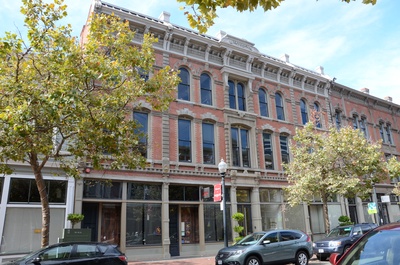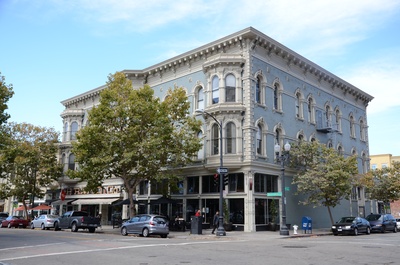Old Oakland is an historic neighborhood of Oakland. The neighborhood roughly centers on the intersection of Washington and 9th St., extending east to Broadway, south to Interstate 880, west to Interstate 980, and north to City Center.
During the late 1800s Old Oakland was the place to be. It was in this neighborhood that City parades began and ended. Old Oakland was home to the City’s best hotels (boasting the luxury of grand ballrooms and “modern,” semi-detached washroom corridors), offices, stores and elegant restaurants. The neighborhood could offer the prosperous businessman prime property, grand shops, a thriving fresh-food market, and the most modern amenities. Old Oakland became home to fine established businesses operated by wealthy entrepreneurs. 2
Oakland’s first town plat was oriented around the foot of Broadway; water transportation and waterfront industry have always been vital to the city’s economy. Since the mid 20th century, the waterfront has been evolving to more recreational and residential uses. 1
”Old Oakland refers to the six blocks bounded by Broadway, Jefferson, 7th and 10th Streets. This 1870’s commercial district grew up along the 7th Street railroad line. For most of the 20th century, it survived by neglect as new development moved north up Broadway. The shopping district of the late 19th century and early 20th century, centered at 12th and Washington Streets, underwent decades of “misguided improvements” and was cleared with barely a whimper in the 1970’s. 1
 Snyder’s Block 1879 in Old Oakland
Snyder’s Block 1879 in Old Oakland
photo CC-A from Our Oakland  Old Oakland
Old Oakland
photo CC-A from Our Oakland
History
Old Oakland was part of the original downtown commercial district. Most of the neighborhood’s signature Victorian buildings were constructed in the 1870s and 1880s. After the earthquake of 1906, the area became economically depressed and many of the buildings were left vacant. The neighborhood remained depressed until substantial renovation efforts began in the 1980s.
Just as development away from the waterfront had created the commercial nucleus at Ninth Street, the continuation of that growth eventually relocated the City’s center still farther northward, at Broadway and Fourteenth Street. By the turn of the century, the grand shops and the leading businessmen, many of whom had been the City’s founders, were gone from Old Oakland. The neighborhood remained an important center for more modest commercial activity until the end of World War II, when most major U.S. cities experienced the “flight to the suburbs” syndrome. It was then that the Old Oakland neighborhood began its decline.
For the next thirty years the finest collection of historic buildings in the West deteriorated so badly that some of the structures had to be condemned. A stranger walking those littered streets would never have guessed that a once elegant history was buried beneath the buildings’ neglected and tattered façades. 2
Attractions
Today Old Oakland is a vibrant commercial and residential neighborhood that includes numerous shops and restaurants. It also hosts the Chinatown Farmer’s Market every Friday morning.
Restaurants and Bars
- La Borinqueña Mex-icatessen
- Cosecha
- Desco
- Caffe 817
- Le Cheval
- District
- The Liege
- Miss Ollie’s
- Rosamunde Sausage Grill
- Tamarindo
- The Trappist
- …
Shops
- Old Oakland Flower Market
- Ratto’s
- Marion and Rose’s Workshop
- The Bookmark Bookstore (Friends of the Oakland Public Library)
- Taylor's Sausage
Adjacent Neighborhoods
Pages tagged “Old Oakland”
Links and References
- An Architectural Guidebook to San Francisco and the Bay Area by Susan Dinkeispiel Cerny
- The history of Old Oakland



